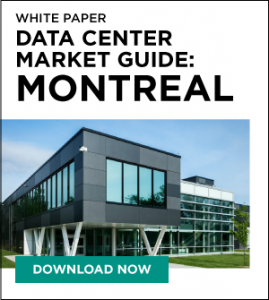When it comes to making infrastructure decisions for your organization’s data, the era of either-or is over. For a time, the emergence of the cloud was viewed as a magic wand for organizations—and incorrectly touted as a data center killer. Yes, the cloud is an affordable, flexible place to store any and all organizational data and access it on-demand anytime, anywhere. However, organizations who went full cloud or remained solely on data center turf may now be left feeling like they’ve missed out. In this series, we’ll explore the spectrum of cloud to purpose-built data centers as a continuum, and how each option can function in conjunction with the others. Companies may choose to move back and forth along that span to leverage options at different scales.
Approach your data center strategy needs as you would your health—diagnose intelligently and prescribe practical, effective solutions with the future in mind. For the vast majority of the world’s organizations, a successful data center strategy means one built upon a combined cloud/data center approach. You don’t need a crystal ball to anticipate evolving needs as your organization grows and matures—you just need the right insights, and the basic blueprint of what a smart growth strategy looks like. A successful strategy is much more complex than “do I put my infrastructure in the cloud or in a data center?” Today, most companies understand that they will need to incorporate elements of both. For example, cloud is great for certain needs, but it isn’t right for everything—similarly, owning and operating your own data center infrastructure won’t work for everyone but may be ideal for certain scenarios. There are few circumstances today where a single approach is the smartest choice for an organization’s data center strategy.
In the next four installments, we’ll outline how the typical growth cycle may evolve, along with a brief digest on what each solution is ideal for and why the data center remains critical to your overall IT strategy.
Part I: The Extended Stay Hotel – The Public Cloud
When you think of the cloud, what comes to mind? We’d venture to guess that many picture an amorphous computing engine with nebulous perimeters and limitless processing power—that somehow, somewhere, processes anything you throw at it. Public cloud services like Azure and Amazon Web Services are abundant today and can offer fast, easy scaling. But it’s too easy to put out of mind the fact that a cloud model still requires physical infrastructure in someone else’s data center. In fact, the more organizations store data in the cloud, the more physical space is required somewhere. And that space costs money.
When public cloud works: If you’re a young startup with uncertain needs and demands, you are most likely learning as you go. You need a low-cost solution that allows you to pay for what you use right now—which could be anywhere between one and 100 kilowatts. (If you’re operating at this scale, you could comfortably employ a cloud-only solution—though cloud is typically not measured in power consumption.) You may find investing time and energy for long-term strategic planning daunting at this stage. Right now, the main priority is to establish your offering and provide value for your customers. At this juncture, employing a public cloud model is safe, affordable and easy. As you find your footing, it probably feels most comfortable to hand the keys to someone with years of experience driving, and cloud services certainly offer this benefit. If your requirements are speed and flexibility, with no long-term commitment, cloud is indeed your best option.
When it doesn’t: In your early years—or months—the public cloud model may work swimmingly. However, as your company expands, your offering matures and demand grows, the “pay-as-you-go” public cloud model will stop making sense for certain elements of your business. If that’s happening now, it might be time to plant some roots. Public cloud gives you no control over management of the facilities from which it’s deployed or how they run that environment, and you likely have no physical access to your infrastructure. When you began using public cloud, your required capacity was minimal and your costs were low. Now, as your offering diversifies and grows, your expenses are increasing exorbitantly. If you continue along this path, you may find yourself in a holding pattern as you are forced to pay handsomely for workloads that make much more sense planted on firm ground.
How to use public cloud: As your needs proliferate, you’ll want to pick and choose your own components, and leave room to augment services and experiment with creative ideas. For example, your critical infrastructure may need to be up and running 100 percent of the time, but your R&D lab may only need to breathe during work hours. Why should you pay the price of mission critical redundancy for something that sleeps sixteen hours a day? You also might have compute loads that fluctuate wildly; with public cloud you only pay for this capacity when you need it. When that higher capacity starts to become the norm (ie. bursting is constant) then the cost model might force you to start thinking about a data center strategy that gives you more day to day control.
While understanding that public cloud may still serve well as a component of your overall infrastructure, you may need somewhere you can put down some physical roots as well—something you can access day and night and reign over, and that permits you to focus on your priorities. Public cloud will always have ideal application in certain instances, but for those of you who may need to more actively manage data as you grow, it’s important to consider other options. In the next three installments of this series, we’ll explore the benefits and drawbacks of retail, wholesale and building your own data center to ensure that you find the customized prescription that fits your needs.
A Prescription for Your Data Center Strategy Part I
Sureel Choksi
Serving as President and Chief Executive Officer, Sureel has over 19 years of experience as an executive in the Internet infrastructure industry. He is also a member of Vantage’s board of directors. Sureel was previously an Operating Executive at Silver Lake Partners, and prior to that Chief Executive Officer of Elevation Data Centers, a private-equity backed roll-up vehicle. Sureel previously held several executive roles with Level 3 Communications, including Chief Marketing Officer, President of Wholesale Markets, Executive Vice President of Services, Chief Financial Officer, Group Vice President of Corporate Development and Treasurer. Before Level 3, Sureel worked in venture capital at TeleSoft Partners and investment banking at Gleacher & Company.
Sureel received a B.S. in Economics from the Wharton School with concentrations in Finance, Accounting and Entrepreneurial Management, and a B.A.S. from the School of Engineering and Applied Science, both from the University of Pennsylvania.



